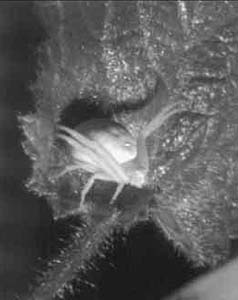|
|
|
|
|
Various galls could be found in any one churchyard, and, within a single gall, other creatures may live, either sharing accommodation and food source or actually making a living as parasites. Apart from planting to attract butterflies and the larger moths, about which much has been written, there are vast numbers of smaller - often minute - moths, some of them, again, leaf miners. The beetle- mites, woodlice and millipedes that feed on the leaf litter help to reduce it to humus, and they have been adapted to such a lifestyle over millions of years. Many also feed on rotten wood, and good foresters always leave some branches and logs that will act as cover for such invertebrates after fungi have softened the tissues. Quite large tree trunks left at the sides of a graveyard will attract much animal life, and can even be used as seats by humans for many a year! The predatory mites, centipedes and pseudoscorpions prey upon the humus feeders, ensuring a reasonable balance. Some spiders prey on woodlice but more snare flying insects. Some of the crab spiders, which owe their name to the crab- like way that they spread their legs, are bright green or yellow. They are often to be seen sitting in the middle of flowers, and even those with extreme arachnophobia often find them attractive and not at all frightening. An interesting addition to our fauna since about 1925 has been the New Zealand landhopper which, being brown, shiny, flattened from side to side and capable of prodigious leaps, is sometimes mistaken for a giant flea. At 15 millimetres long it would make even the giant mole flea, which reaches six millimetres, look small! Feeding on leaf litter, landhoppers make a valuable contribution to soil formation and are also, presumably, attractive to birds, which certainly feed avidly on the related shorehoppers. Not all slugs and snails feed on green plants. Some eat decaying matter and others scavenge animal remains and droppings. Of the 70 or so land snails and slugs that have been recorded in Cornwall, most measure less than a centimetre, whilst one, Punctum pygmaeum, is only just over a millimetre! Not so much to fear from that small grazing tongue! One of the few Cornish sightings of rock snail Pyramidula rupestris, which is mainly confined to limestone in England and Ireland, occurred in Landulph Churchyard many decades ago. Stella Turk |
|
All creatures great and small How close is your nearest nature reserve? As Stella Turk reports, you need go no further than the local churchyard. Saint Francis of Assisi has always been my favourite saint but even he may not have been aware of the importance of such lowly creatures as worms, grubs, woodlice and slugs to the birds and mammals that he loved, not forgetting the frogs and toads. We have had to become more aware of food chains as our power of controlling "pests" has grown to the point where there is a noticeable decline in many insects, like bees and dung feeders, which we need for productive crops. It is the decline of bats and many insecteating birds that has alerted us to the damage that we are causing. Indeed it is difficult to destroy those we don't want without harming those that we do. In "God's own acres" we have a chance to show wise reverence for all life. Many churchyards have inventories of the wild plants they contain - the ferns, mosses and lichens as well as the flowering plants. There is, of course, a direct relationship between the diversity of the vegetation and the number of different animal species. Large numbers of beetles, moths and butterflies, bark- lice and plantlice feed only on one group or even one species of plant. The leaf miner of the holly is the larva of a minute fly, galling the leaves with an irregular yellow patch; it is found on no other plant. |
|
